Carlisle and the Border Reivers
by Julia Hickey
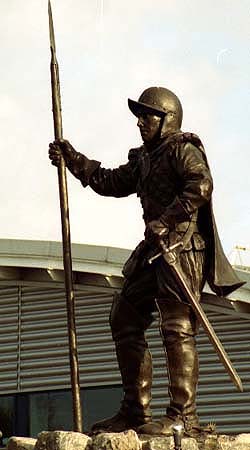 Welcome to the
16th century and the frontier between England and Scotland. This
is a lawless land; rustling, murder and lynching are everyday
occurrences. This is a place where a man's safety depends upon
his prowess in arms and the power of his extended family -- not
to mention the thickness and height of his walls! For this is the
lawless realm that introduced the words 'bereave' and 'blackmail'
to the English language. In these harsh times the feuding
inhabitants -- Grahams, Armstrongs, Nixons, Maxwells and
Musgraves -- owe allegiance to no one but themselves. A traveller
falling into the clutches of an armed gang pleaded with them for
mercy. "Are ye no Christians?" he begged. Welcome to the
16th century and the frontier between England and Scotland. This
is a lawless land; rustling, murder and lynching are everyday
occurrences. This is a place where a man's safety depends upon
his prowess in arms and the power of his extended family -- not
to mention the thickness and height of his walls! For this is the
lawless realm that introduced the words 'bereave' and 'blackmail'
to the English language. In these harsh times the feuding
inhabitants -- Grahams, Armstrongs, Nixons, Maxwells and
Musgraves -- owe allegiance to no one but themselves. A traveller
falling into the clutches of an armed gang pleaded with them for
mercy. "Are ye no Christians?" he begged.
The response came, "No, we're Elliotts."
Today Cumbrians will give you a warm and friendly welcome, but
the landscapes, often stark but always stunning, resonate with
the history of a turbulent past.
Where better to begin than the administrative centre of the
Western Marches? Visit the Carlisle tourist information office in
the market place. It is situated in the predominantly
18th-century Old Town Hall, but the oldest parts of the building
survive from Queen Elizabeth's reign. Maps, books and leaflets
containing everything from opening times to walks and cycle rides
and the history of the region can be found here. Pause to admire
the market cross from where Bonnie Prince Charlie declared
himself to be king of England before visiting Tullie House, now
Carlisle's award-winning museum.
Here, a permanent exhibition, including a dramatic film show that
runs for approximately ten minutes, sets the scene for the brutal
but compelling history of the reivers who roamed the borders
between England and Scotland for more than 300 years. Reiving was
not only the passtime of outlaws and bullies; respectable men
reived their Scottish neighbours' sheep and cattle. Theft and
countertheft were so engrained in the border way of life that
rules for Truce Days and regulations for pursuing reivers were
devised to ensure some sort of established authority and code of
conduct. If a man's cattle were stolen a crown officer could
call for a "hot trod:" a sod of burning peat was hoisted on a
spear and the wronged party could travel unhindered into the
neighbouring country in search of his belongings. In theory,
law-abiding people were supposed to provide assistance to men
riding in pursuit of stolen goods, but in practice this was often
not the case.
This systematic lawlessness and violence grew from the border
wars that raged between England and Scotland during the medieval
period, when the borderers suffered the consequences of invasion
and counter-invasion. Carlisle Castle itself changed hands
between the English and the Scots on several occasions during
this period. By the time of Henry VIII, border warfare was
sporadic and Carlisle was firmly under English control. Still,
the danger of invasion, looting and pillaging remained constant
-- though more seasonal than during the years of open warfare --
because for the borderers it had become a way of life.
Living with the constant threat of violence bred a very
aggressive race of people. If they weren't fighting the Scots
they were arguing amongst themselves. They were very proud and
took offence easily, so that before many centuries had passed
whole families were at feud with one another over some ancient
vendetta. It is even said that borderers traditionally excluded
the sword hand of any male child to be christened so that in time
of raiding and blood feud he would be all the stronger in his
fighting for not having to worry too much about damnation!
The principal reivers gained a reputation for villainy
because they didn't abide by the rules and robbed from both the
Scots and the English side of the border. Many of their deeds
were handed down in legend and song before being immortalised by
Sir Walter Scott. Find out at Tullie House if you're descended
from border bandits; inspect steel bonnets, short swords and
double headed axes; hear the sad tale of Isabel Routledge left
widowed by a reiver raid. The coffee and cake served in the
cafeteria are pretty good too.
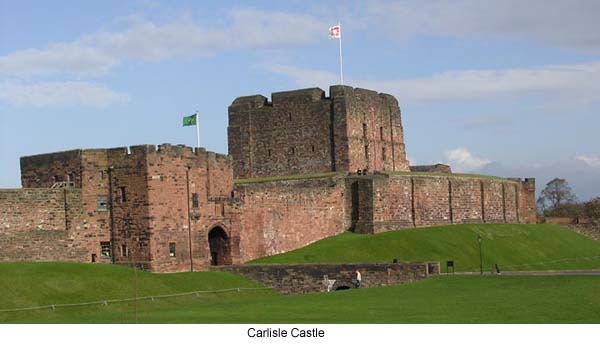
Then take a short journey through the millennium subway that
links Tullie House with the imposing red sandstone castle. The
black granite pavement is inscribed with a roll-call of riding or
raiding surnames and at the entrance stands the "Bishop's" stone
-- a huge speckled boulder testifying to one man's anger at the
reivers' misdeeds. By 1524 the church was determined to act to
stop the reivers' ungodly ways. Cardinal Wolsey described the
marches as an "evil country," but the Bishop of Glasgow was
rather more specific. The stone carries part of the extensive
curse that he had read from pulpits in neighbouring Tynedale when
he excommunicated every single reiver in the land. Unfortunately
for law abiding citizens (and there don't seem to have been many)
it doesn't seem to have had a great deal of impact on the broken
men in the Debateable Lands (patches of disputed territory that
acted as a buffer zone between England and Scotland) or the
career criminals who lived in the region. The Debateable Lands
were ideal for men who might have reason to fear the law. In
addition to being isolated and often mountainous, neither kingdom
would recognise the authority of the other in these disputed
regions. This allowed the "broken men" who lived there to play
one warden off against another with little fear of
retribution.
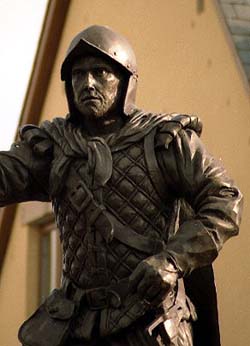 Broken men were reivers
who had been formally outlawed by either the Scottish or English
authorities. For example, if someone -- let's call him Jack --
was involved in a murder, the chief of Jack's family might be
asked to stand bail for him. If the head of the family refused,
then Jack would be "put to the horn." This meant that he was
declared an outlaw in the nearest convenient market square and in
theory if he was caught he could be hung. By refusing to stand
bail for Jack, the clan chief had denied that Jack belonged to
his family. In practice, of course, no one took a great deal of
notice of their broken status. One family of Armstrongs was
notable because they were all broken men! Broken men were reivers
who had been formally outlawed by either the Scottish or English
authorities. For example, if someone -- let's call him Jack --
was involved in a murder, the chief of Jack's family might be
asked to stand bail for him. If the head of the family refused,
then Jack would be "put to the horn." This meant that he was
declared an outlaw in the nearest convenient market square and in
theory if he was caught he could be hung. By refusing to stand
bail for Jack, the clan chief had denied that Jack belonged to
his family. In practice, of course, no one took a great deal of
notice of their broken status. One family of Armstrongs was
notable because they were all broken men!
As you come up out of the subway, the castle awaits. It has
stood guard over Carlisle for more than 300 years. Henry VIII,
recognizing the role of gunnery in warfare, added the half-moon
battery inside the outer courtyard. During the 16th century it
was occupied by the Warden of the Western Marches. It also
played host to Mary Queen of Scots and in 1596 to a rather less
illustrious Scotsman -- Kinmont Willie Armstrong, a notorious
headsman of an equally notorious border family.
Armstrong was arrested on a truce day when all the inhabitants of
the region could meet for markets, games and justice. He was
taken to Carlisle Castle by English officers of the crown where
the warden, Lord Scrope, threw him into prison. This was
contrary to border law. The Laird of Buccleuch, the Keeper of
Liddesdale -- a Scottish officer -- roused his forces and
together with Willie's family rode for Carlisle. They crossed
the River Eden with scaling ladders, intending to go over the top
of the castle walls. This plan went awry when the ladders
collapsed. Undeterred, the resourceful Scots kicked open the
postern gate, discovered Armstrong -- bound by chains that
rattled loudly -- and escaped back over the storm swollen river
waters. The story continues:
We scarce had won the staneshaw-bank,
When a' the Carlisle bells were rung,
And a thousand men, in horse and foot,
Cam wi' the keen Lord Scrope along
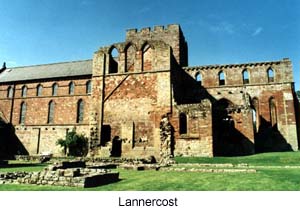 Scrope and his thousand men didn't recapture Willie
Armstrong. The crows at Harraby gallows were deprived of their
meal. No doubt Scrope, who had to explain the escape to
Elizabeth, wished that he had incarcerated Armstrong in the dark
dungeons beneath the keep where the only moisture to be had was
from the notorious "licking stone." The dungeons are open to the
public and retain a damp cold feel -- not the kind of place you'd
want to be on your own in the middle of the night. Scrope and his thousand men didn't recapture Willie
Armstrong. The crows at Harraby gallows were deprived of their
meal. No doubt Scrope, who had to explain the escape to
Elizabeth, wished that he had incarcerated Armstrong in the dark
dungeons beneath the keep where the only moisture to be had was
from the notorious "licking stone." The dungeons are open to the
public and retain a damp cold feel -- not the kind of place you'd
want to be on your own in the middle of the night.
Follow Armstrong and Buccleuch north, out of Carlisle towards
junction 44 of the M6. Scotland Road boasts a 10-foot-tall
reiver clad in steel bonnet and leather jack, gazing out towards
the hills. Follow the A689 to Brampton and continue to
Lanercost. You are at the very edge of the Debateable Lands,
where neither England nor Scotland ruled.
Lanercost Priory, now a ruin, was abandoned in 1535 during the
Dissolution of the Monasteries. The priory is small but
beautiful. An informative audio-tour takes visitors around the
walls, undercofts and rooms. The tour can be paused and visitors
can take time to explore on their own or sit on a bench enjoying
the sun and the sound of birdsong. This is a place that feels a
million miles from the 21st century. But in the 16th century it
wasn't so much a backwater as a frontline. So it isn't surprising
that the site should contain two pele towers.
There are more than 100 pele towers and bastle houses in Cumbria.
A pele tower is a stoutly built tower, rather like a medieval
keep -- and indeed many of them date from the 13th century when
wars between England and Scotland raged. The wealthy lived in
pele towers; other borderers equipped themselves with bastle
houses. A bastle house is a basic tower with a store room at the
bottom. This could be used for livestock or it could be packed
with peat, which was then set alight, deterring reivers who were
thus denied easy access to the first and second floors of the
house. Bastle houses were used as refuges rather than permanent
living quarters. When beacon lights filled the skies, families
would gather their valuables and lock themselves in these
buildings and hope that the reivers would bypass their homes and
livestock. Pele towers and bastle houses are unique to the
British Isles.
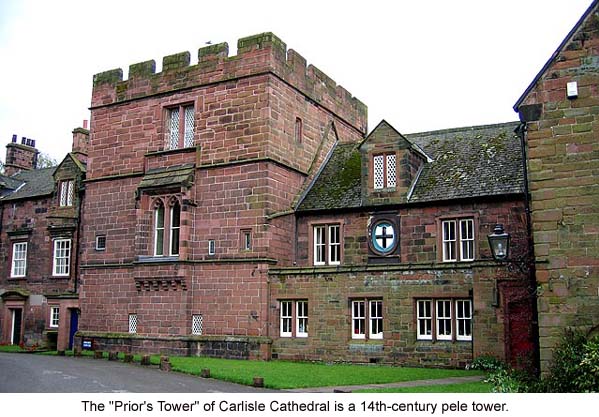
The rest of the population, living in huts with thatched roofs,
could either find shelter with a rich relation or rely on the
thickness of their church walls for sanctuary. The fortified
church at Great Salkeld in the Eden Valley is an excellent
example, with walls six feet thick, a sturdy tower and a large
room beneath the ground floor where frightened woman and children
could hide until the danger passed.
Following the Union of England with Scotland, James I (James VI
in Scotland) ordered that these fortified buildings be demolished
in an attempt to pacify the region. The majority of surviving
towers became part of the fabric of working farms, like the one
at Askerton on the way to Bewcastle. Others were converted into
more comfortable stately homes. Two examples can be found near
Penrith: Hutton-in-the-Forest and Dalemain. Both are open to the
public. The pele tower at Dalemain lies at the heart of the
existing building. The cafeteria is situated in the medieval
hall. It is also home to a fine collection of doll's houses and
a delightful house for mice built into one of the wooden stairs.
Take a walk along the footpath from Dalemain to Dacre for a
glimpse of yet another tower. Dacre isn't open to the public and
the path can be muddy at times but the church is worth a visit
and the pub serves hearty meals.
If you want to visit an unaltered pele tower, there are several
fine examples beyond the Western Marches. The best example in
England is called Aydon Castle, near Hexham. Built in the 13th
century, it still retains its barmkin -- an enclosed courtyard
for livestock. Two others, Smailholm and Hermitage -- home of
infamous border baron Bothwell -- are in Scotland.
Follow the winding lanes deep into the hills beyond Lanercost for
a visit to Bewcastle. This isolated village is home to a Roman
fort, a castle and the Bewcastle Cross. It was also the home of
Hobbie (short for Halbert) Noble, who features in one of Scott's
border ballads: "his misdeeds they were sae great, they banished
him to Liddesdale."
Today, there is no sign of Hobbie, but a quick inspection of the
churchyard reveals many reiving names: Armstrong, Storey, Bell
and of course Noble. The East Cumbria Country Side Project
offers two walks from Bewcastle. The leaflet is called "Bastles
in the West March." It can be purchased from Carlisle Tourist
Information Office.
Head back towards Hadrian's Wall and Hexham. On the way there you
might want to stop at Housesteads, the most complete Roman fort
in Britain. Nearby are the remains of a bastle and farmhouse
owned by generations of Armstrongs who also claimed Housesteads
as theirs. The last Armstrong to own the fort -- which made an
ideal centre for his horse stealing operation -- was hung at the
beginning of the 18th century. His brothers fled to America, no
doubt to avoid a similar end.
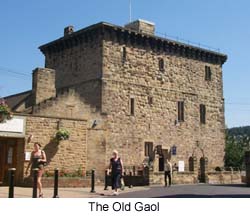 Hexham, "the capital of Tynedale," is in the English
Middle March. This little town is built around the impressive
Saxon abbey. It also contains the first purpose-built prison in
England. Built in 1330 to contain convicted reivers, it is now
the home of the Border History Museum. Having reopened in 2005
after extensive renovations, it is well worth a visit. An
audio-visual tour leads visitors through the gaol, which depicts
tragic and terrible tales. Experience a reiver raid; listen to
the tragedy of the English lassie who loved a bonnie Scot's lad;
and relive the tale of the scabby sheep. A newly installed glass
lift carries visitors down to the dungeons for a glimpse of the
convicted reivers' quarters, and if there's time (and a volunteer
available), you can browse through some of the ballads and
stories stored in the Hexham Moothall Border Library collection
now rehoused in the old goal. Hexham, "the capital of Tynedale," is in the English
Middle March. This little town is built around the impressive
Saxon abbey. It also contains the first purpose-built prison in
England. Built in 1330 to contain convicted reivers, it is now
the home of the Border History Museum. Having reopened in 2005
after extensive renovations, it is well worth a visit. An
audio-visual tour leads visitors through the gaol, which depicts
tragic and terrible tales. Experience a reiver raid; listen to
the tragedy of the English lassie who loved a bonnie Scot's lad;
and relive the tale of the scabby sheep. A newly installed glass
lift carries visitors down to the dungeons for a glimpse of the
convicted reivers' quarters, and if there's time (and a volunteer
available), you can browse through some of the ballads and
stories stored in the Hexham Moothall Border Library collection
now rehoused in the old goal.
In addition to discovering the border reivers by car and by foot
it is also possible to take to two wheels. Follow all or part of
the 175-mile Reivers Cycle Route. Whichever mode of transport you
choose, you'll be fascinated by the life and times of the likes
of Kinmont Willie, Bold Buccleuch, Jock o'the Side, Dick o'the
Cow, Johnie Armstrong and Belted Will.
Related Articles:
- Lancaster, by Elizabeth Ashworth
- https://www.timetravel-britain.com/articles/towns/lancaster.shtml
More Information:
Books:
These resources are invaluable if your appetite for border
history has been whetted.
Durham, Keith. (1995). The Border Reivers. (Osprey
Publishing.) A good introduction to the reivers and some
dramatic colour plates including one depicting the rescue of
Kinmont Willie from Carlisle Castle.
MacDonald Fraser, George. (1971). The Steel Bonnets.
(HarperCollins.) This is the definitive book offering a
detailed history of the reivers and their unsavoury habits
Moss, Tom: Deadlock and Deliverance. The capture and rescue of Kinmont Willie Armstrong, the most notorious Scottish Reiver of the 16th century, was the last great event in the reivers' history.
It would prove to be the last time the Reivers, adhering to a society which put allegiance to the clan first and foremost, would clash with both Scottish and English authority and monarchy on a scale which would shake both nations. http://www.reivershistory.co.uk
Ordnance Survey: In Search of the Border Reivers.
A useful map for pinpointing reiver haunts in Cumbria,
Northumbria and Scotland. It also provides a timeline and a list
of reiver family names.
Reed, James (ed). (1991). Border Ballads -- A
Selection. (Carcanet Press.) In addition to a selection
of the most dramatic ballads from a variety of sources, Reed
provides a short history of the period and commentary to
accompany the ballads.
More Information:
We regret that we no longer have the resources to maintain up-to-date links and/or hours and pricing details for the various sites and attractions listed on this website. For more information about the location(s) listed above, please use your favorite search engine or visit Wikipedia.
Julia Hickey is passionate about England's heritage and particularly of Cumbria, where her husband comes from. In between dragging her family around the country to a variety of historic monuments, she works part-time as a senior lecturer at Sheffield Hallam University. She spends the rest of her week writing. In her spare time, she enjoys walking, dabbling in family history, cross-stitch, tapestry and photography.
Article and photos © 2006 Julia Hickey
Pele tower photo courtesy of Visitcumbria.com
| 